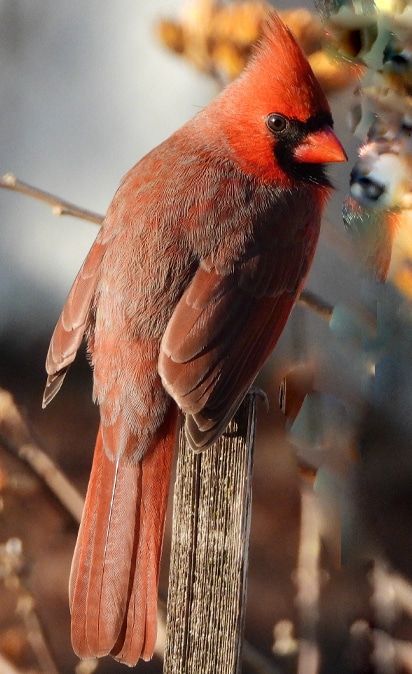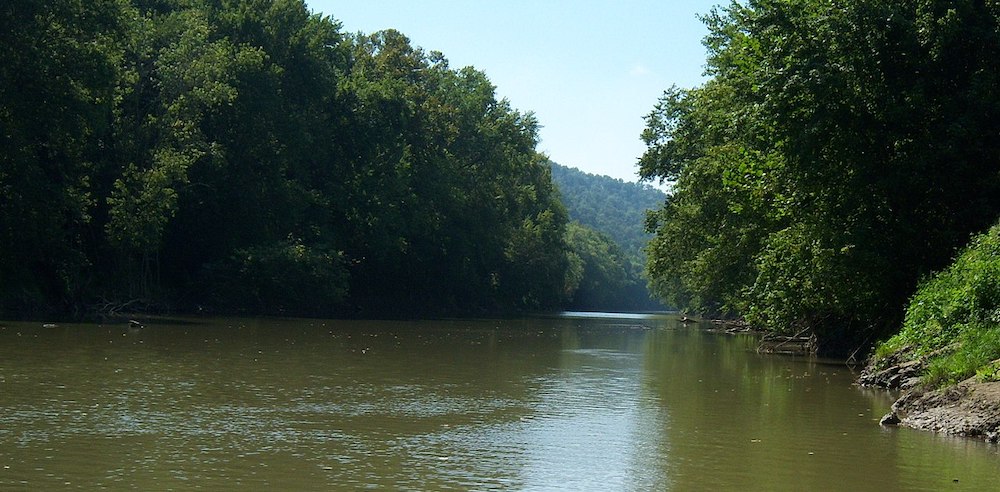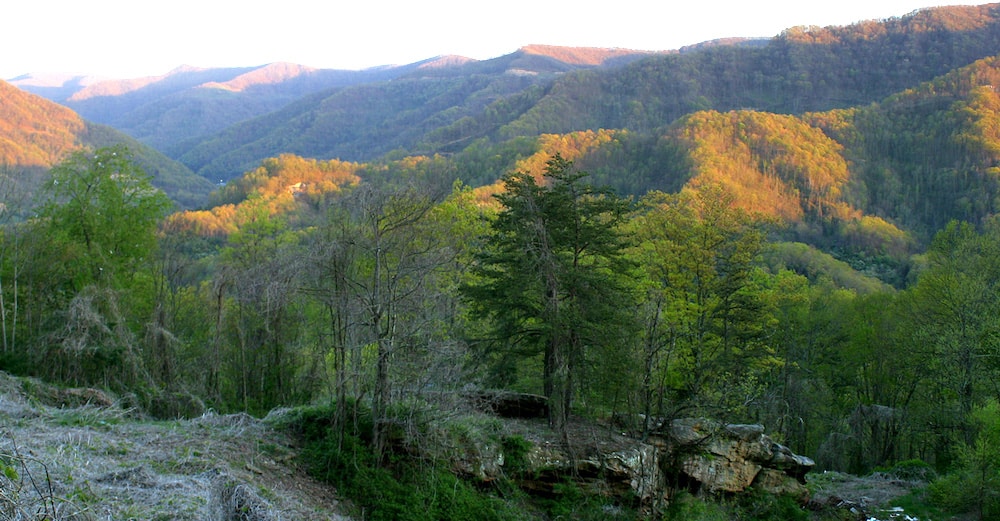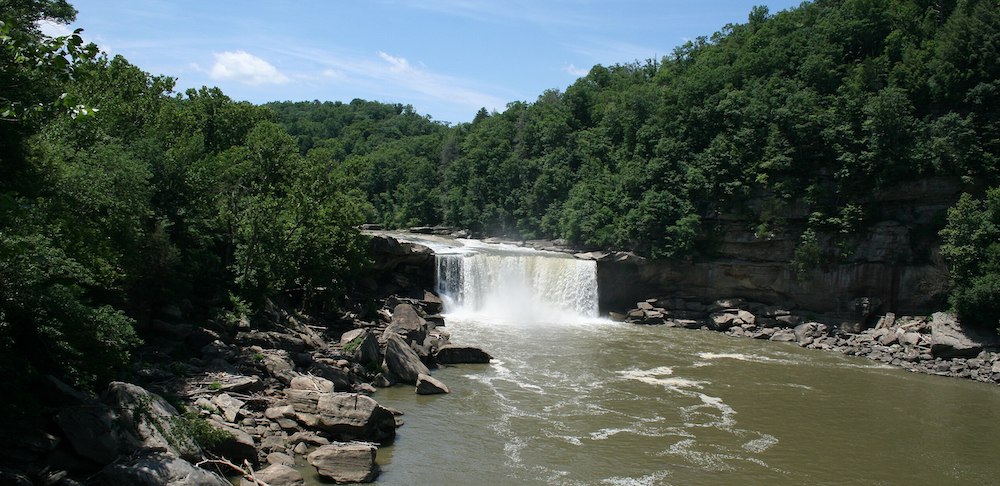Commonwealth of Kentucky

Kentucky is a landlocked state in the Southeastern region of the United States covering nearly 105,000 km2 (40,000 square miles). It is considered part of the Upland South as a significant portion of eastern Kentucky is part of Appalachia. Kentucky borders Illinois, Indiana, and Ohio to the north, West Virginia to the northeast, Virginia to the east, Tennessee to the south, and Missouri to the west. Its northern border is defined by the Ohio River; its western by the Mississippi and the east by Big Sandy River and Tug Fork. Kentucky has a non-contiguous part known as Kentucky Bend, at the far west corner of the state. It exists as an exclave surrounded completely by Missouri and Tennessee, and is included in the boundaries of Fulton County. Road access to this small part of Kentucky on the Mississippi River (populated by 18 people) requires a trip through Tennessee. Kentucky has a population of c.4.5 million people. Its capital is Frankfort and its largest city is Louisville with around 640,000 inhabitants, twice the size of the capital.
The state is home to the world’s longest cave system in Mammoth Cave National Park, the greatest length of navigable waterways and streams in the contiguous United States, and the two largest artificial lakes east of the Mississippi River.

Levisa Fork in Paintsville – ©J654567, CC BY-SA 3.0 via Wikimedia Commons
Though it has only three major natural lakes, Kentucky is home to many artificial lakes. Kentucky can be divided into five primary regions: the Cumberland Plateau in the east, which is wholly underlain by coal and constitutes the Eastern Coal Field; the north-central Bluegrass region, where the major cities and the capital are located; the south-central and western Pennyroyal Plateau (a Mississippian-age plateau that is divided into eastern, central and western sub-regions, the latter known as the Pennyrile); the Western Coal Field; and the far-western Jackson Purchase, the northernmost extension of the Mississippian Embayment, west and south of the Tennessee River. The Bluegrass region is commonly divided into two regions, the Inner Bluegrass encircling 90 miles (140 km) around Lexington, and the Outer Bluegrass that contains most of the northern portion of the state, above the Knobs. Much of the outer Bluegrass is in the Eden Shale Hills sub-region, made up of short, steep, and very narrow hills. The alluvial plain of the Ohio River is another geological region, as is the area south and east of Pine Mountain, part of the Ridge and Valley Belt of Appalachia.

Black Mountain – ©iLoveMountains.org, CC BY 2.0 via Wikimedia Commons
Kentucky has a climate that is best described as a humid subtropical climate, only small higher areas of the southeast of the state has an oceanic climate influenced by the Appalachians. Temperatures in Kentucky usually range from daytime summer highs of 31 °C to the winter low of −5 °C. The average precipitation is 46 inches a year. There are four distinct seasons, with substantial variations in the severity of summer and winter. The highest recorded temperature was 46 °C (1930), while the lowest recorded temperature was −38 °C (1994). The state rarely experiences the extreme cold of far northern states, nor the high heat of the states in the Deep South. Temperatures seldom drop below 0 degrees or rise above 100 degrees. The climate varies markedly within the state. The northern parts tend to be about five degrees cooler than those in the western parts of the state. Somerset in the south-central part receives ten more inches of rain per year than, for instance, Covington to the north. In general, Kentucky has relatively hot, humid, rainy summers, and moderately cold and rainy winters.
Birding Kentucky
Kentucky hosts multiple habitats with a high number of endemic species, including in some of the most extensive cave systems in the world. 102 species are known to be endemic to the state.
Kentucky has been part of two of the most successful wildlife reintroduction projects in United States history. In the winter of 1997, the Kentucky Department of Fish and Wildlife Resources began to re-stock elk in the state’s eastern counties, which had been extirpated from the area for over 150 years. As of 2009, the herd had reached the project goal of 10,000 animals, making it the largest herd east of the Mississippi River. The state stocked wild turkeys in the 1950s. There were reported to be fewer than 900 at one point. In 1991 the Land Between the Lakes partnered with the U.S. Fish and Wildlife Service for the Red Wolf Recovery Program, a captive breeding program.

Cumberland Falls – ©ChrisKuehl, Public domain, via Wikimedia Commons
Kentucky has an expansive park system, which includes one national park, two National Recreation Areas, two National Historic Parks, two national forests, two National Wildlife Refuges, 45 state parks, 37,896 acres (153 km2) of state forest, and 82 wildlife management areas. At first glance, Kentucky appears to merely be a state which hosts some great birds which can be seen elsewhere in the company of more exotic species. Kentucky natives know better; as a Mississippi flyway state in the mid-south, our state offers a highly varied list of species from all four compass points. Where else can one find Swainson’s Warblers, Snowy Owls, Prothonotary Warblers, Dicksissels, Bell’s Vireos, Ravens, Thayer’s Gulls, and Greater White-fronted Geese, all within a calendar year. Add the occasional Red-necked grebe, nesting Scissor-tailed Flycatchers, and a sporadic Evening Grosbeak invasion, and you begin to see why we don’t mind birding close to home. Every location has its rarities, but ours can (and do) come from anywhere. The species total for the state is currently approaching 350.
Most of Kentucky is very rural, with the Appalachian Mountains in the east; mixed farmland and hardwood forest throughout the central region; and open farmland giving way to river bottoms in the west. Like much of rural America, it is strikingly beautiful. Its residents are generally friendly and hospitable. A complete list of birding locations can be found at the Kentucky Ornithological Society (KOS) web site, given below. A birder with some time to spend in the state will want to hit four main regions set out in the Top Sites below.
-
Central Region
The central regions of the state are rich in rural birding habitats. This is the area with the least number of local specialties, but many good species turn here. Spring and fall migrations can be especially fruitful. Check state and national parks. Wintering raptors such as bald eagles and peregrine falcons are regular. -
Eastern Mountains and Cumberland Plateau
The eastern mountains and Cumberland Plateau host species found nowhere else in the state. The elevation of this region makes it suitable for many breeding passerines typically found in more northern locations. Specialties of the region include many breeding warblers, ruffed grouse, veery, ravens, and regular saw-whet owls in winter. -
Northern Kentucky
Northern Kentucky near Cincinnati draws the best concentrations of winter residents, such as snow buntings, snowy owls (rare but regular); all three species of scoters on the Ohio River, and rough-legged hawks. -
Western Kentucky
Western Kentucky includes two man-made lakes, as well as the Mississipi flyway. This region, like the Cumberland plateau, is essential birding. For a state poor in wetlands and open water, these regions provide the majority of waders and waterfowl. Migration periods and winter birding can be excellent, with wintering white pelicans, gulls, and raptors. Breeding Mississippi kites, scissor-tailed flycatchers, black-necked stilts, and least terns make spring and summer trips fruitful.
-
Number of bird species: 407
(As at July 2024)State Bird: Northern Cardinal Cardinalis cardinalis
-
Avibase
PDF ChecklistThis checklist includes all bird species found in Kentucky , based on the best information available at this time. It is based on a wide variety of sources that I collated over many years. I am pleased to offer these checklists as a service to birdwatchers. If you find any error, please do not hesitate to report them. -
Birds on the Daniel Boone National Forest
Annotated ChecklistThe Daniel Boone National Forest, administered by the Forest Service under the United States Department of Agriculture, manages over 707,000 acres in 21 counties of eastern Kentucky. -
Kentucky Ornithological Society
Annotated ChecklistThe Annotated Checklist of the Birds of Kentucky, a KOS-sponsored project, was first published in 1988... -
Shaker Village of Pleasant Hill
ChecklistThis checklist includes more than 150 species of birds presently known to have occurred inside the boundaries of Shaker Village of Pleasant Hill and along the Kentucky River Gorge. -
Wikipedia
Annotated ListThis list of birds of Kentucky includes species documented in the U.S. state of Kentucky by the Kentucky Bird Records Committee (KBRC) of the Kentucky Ornithological Society through January 2023. -
eBird
PDF ChecklistThis checklist is generated with data from eBird (ebird.org), a global database of bird sightings from birders like you. If you enjoy this checklist, please consider contributing your sightings to eBird. It is 100% free to take part, and your observations will help support birders, researchers, and conservationists worldwide.
-
Annotated Checklist of the Birds of Kentucky
| By Brainard Palmer-Ball, Jr. | Kentucky Ornithological Society | Edition 3 | 2019 | Paperback | 266 pages, 5 b/w photos, 2 b/w maps | ISBN: 9780578550770 Buy this book from NHBS.com -
Birds of Kentucky
| By Marc parnell | Naturalist & Traveler Press | 2022 | Paperback | 280 pages, colour photos | ISBN: 9781954228245 Buy this book from NHBS.com -
Birds of Kentucky - Field Guide
| By Stan Tekiela | Adventure Publications | Edition 2 | 2022 | Paperback | 312 pages, colour photos, colour distribution maps | ISBN: 9781647552978 Buy this book from NHBS.com -
Endangered and Disappearing Birds of Appalachia and the Southeast
| By Matt Williams | UP of Kentucky | 2024 | Hardback | 264 pages, 118 colour photos, 49 colour distribution maps | ISBN: 9780813198361 Buy this book from NHBS.com -
Kentucky Birds
| (A Folding Pocket Guide to Familiar Species) | By James R Kavanagh & Raymond Leung | Waterford Press | 2000 | Unbound | 12 pages, colour illustrations | ISBN: 9781583551479 Buy this book from NHBS.com -
Kentucky Wildlife Encyclopedia
| (An Illustrated Guide to Birds, Fish, Mammals, Reptiles, and Amphibians) | By Scott Shupe | Skyhorse Publishing | 2018 | Hardback | 356 pages, 800 colour photos, 600 b/w distribution maps | ISBN: 9781510728820 Buy this book from NHBS.com -
The Birds of Kentucky
| By Burt L Monroe Jr. & William Zimmerman | Indiana University Press | 2021 | Hardcover | 152 pages, 51 colour paintings, map | ISBN: 9780813151410 Buy this book from NHBS.com
-
Bluegrass Birding Festival
WebsiteWelcome back to the Bluegrass Birding Festival! We are looking forward to a fun-filled day of birding. Central Kentucky has great opportunities for birding with over 350 documented species. Entrance to the festival will be FREE and open to the public. Our goals for this festival are to expose as many as possible to the hobby of bird watching and to educate on topics of wildlife and conservation. -
Ohio Valley Birding Festival
Facebook PageThe Ohio Valley Birding Festival is an Evansville Audubon Society event featuring guided spring migratory birdwatching hikes in southwestern Indiana and western Kentucky along with family friendly birding activities at John James Audubon Park in Henderson, Kentucky.
-
John James Audubon State Park Museum
WebpageAlong the banks of the Ohio River just north of Henderson, KY, John James Audubon State Park houses the world's largest collection of Audubon artifacts and offers exhibits on the artist's life. The museum interprets Audubon’s life through his art and personal memorabilia, framed within a timeline of world events….
-
Audubon Society in Kentucky
WebsiteUsual list of local chapters -
Beckham Bird Club
WebsiteThe Beckham Bird Club, Inc. (BBC); in existence for more than sixty years, is a non-profit organization of men, women, and children who are interested in birds, ecology, and nature. It is named for Charles Wickliffe Beckham, the first native Kentuckian to achieve a national reputation as an ornithologist, and was founded in 1935 in Louisville, Kentucky, as the Louisville Chapter of the Kentucky Ornithological Society. Beckham Bird Club members are people who like birds, enjoy watching them, and want to keep in touch with others who also enjoy the sport. -
Bluebirds of Central Kentucky
WebsiteSome of the Earth's greatest environments are threatened by increased urbanization. Our volunteers, with support from the team at West Sixth Farm are creating a Bluebird trail and a community around it. -
Central Kentucky Audubon Society
WebsiteThe Central Kentucky Audubon Society is a member of the National Audubon Society and the Kentucky Audubon Council, and serves ten central Kentucky counties in the promotion of conservation education and awareness. (The Chapter originally took the name Buckley Hills Audubon Society) -
Cumberland Chapter Sierra Club
WebsiteThe Sierra Club Cumberland Chapter was formed over 50 years ago to explore, enjoy, and protect Kentucky. We were formed when Kentucky’s Red River Gorge was under threat of being flooded from a dam proposal in the 1960’s. That dam was stopped and thousands of people from around the world come to visit the famous unique geological area that can still be enjoyed to this day. -
Daviess County Audubon Society
WebsiteToday Daviess County Audubon Society consists of ~100 members: 30 members are active in the organization and the rest are considered subscribers who are interested in the Audubon mission -
Frankfort Audubon Society
WebsiteThe Frankfort Audubon Society's purpose is to connect people with nature through birding education and the conservation of wildlife habitat. -
Friends of Audubon
InformationThe Friends of Audubon is a non-profit organization formed in Henderson, Kentucky in 1984 as a means to support, promote, and enhance John James Audubon State Park. The first major project of the Friends was to raise money to purchase the Tyler Collection, a collection of original artwork and artifacts owned by the descendants of John James Audubon. The Tyler Collection was on loan to Audubon State Park since the Museum opened in 1938. -
Kentucky Audubon Council
WebsiteThe Kentucky Audubon Council is an organization acting as a facilitator among the separate Audubon chapters in the state. The council is comprised of delegates from each Audubon chapter and strives to create a culture of conservation, focusing on environmental issues, education and advocacy. -
Kentucky Bird Records Committee
WebpageThe Kentucky Bird Records Committee (KBRC) maintains the official list of bird species documented as having occurred within the state. The committee receives documentation of bird observations and takes formal votes to determine whether the documentation substantiates the natural occurrence of the species in the wild and within state boundaries. Only rare, out-of-season, or out-of-area species require review by the KBRC. -
Kentucky Ornithological Society
WebsiteFounded in 1923, the KOS strives to create and increase interest in Kentucky birds, and to support bird conservation. KOS members participate in field trips and bird counts, attend spring and fall meetings, and report sightings online. Members receive the quarterly publication, The Kentucky Warbler. -
Little River Audubon Society
Facebook PageMembers enjoy birds and nature, host programs and field trips, sell birdseed, and give scholarships to 5th and 6th graders to attend Halberg Ecology Camp. -
Little Rock Audubon Center
WebpageThere's always a lot going on at our center - indoor and outdoor educational opportunities, walking, birding, workshops and more. -
Louisville Audubon Society
WebsiteThe Louisville Audubon Society (LAS) believes that everyone has the right to enjoy birds, the outdoors, and a healthy and safe environment. We acknowledge that injustice, inequity, and disparity affect many people in our society and this may prevent them from authentically seeing themselves in nature, including here in the Louisville Area. -
Nature Conservancy in Kentucky
InformationThe Mission of The Nature Conservancy is to preserve plants, animals, and natural communities that represent the diversity of life on Earth by protecting the lands and waters they need to survive… -
Raptor Rehabilitation of Kentucky
WebsiteRaptor Rehabilitation of Kentucky, Inc. was formed to: Rehabilitate injured raptors, raise orphaned birds of prey, and increase public awareness about the importance of raptors.
-
*Protected areas of Kentucky
InformationSatellite View03 Protected areas including 8 arboreta, 11 nature reserves, 4 national parks etc. -
Kentucky State Parks
WebsiteSatellite ViewKentucky is home to some of the most beautiful scenery and most interesting historical sites in the country. Our state park system includes 49 parks and one interstate park. Every state park in Kentucky has a web page right here on this site. To find a park you already know about, select it from this list and click go. You can also reach all the parks by clicking on the four sections of the map. -
NF Daniel Boone
WebpageSatellite ViewThe Daniel Boone National Forest offers birders wonderful opportunities to see most of the birds that nest or winter in Kentucky. Birders from all over the state visit the Daniel Boone National Forest every year to add new species to their life lists or just to enjoy seeing some of the less common birds, such as the cerulean warbler, in areas where they are plentiful. If you are planning to visit the Forest and are interested in finding some good bird watching spots, below are a few hot spots you may want to check out. -
NPr Creasey Mahan Nature Preserve
WebsiteSatellite ViewVirginia Creasey Mahan and Howard Mahan cherished wildlife, trees, and the four year-round springs that graced their Hill O’Content Farm, given to them as a wedding present in 1921 by Virginia’s family. Knowing their land was “something special,” they vowed to preserve it for future generations. -
NR Brigadoon State Nature Preserve
InformationSatellite ViewBrigadoon State Nature Preserve is a state nature preserve located in Barren County, Kentucky adjacent to Barren River Lake. -
NR Beargrass Creek Nature Preserve
WebpageSatellite ViewBeargrass Creek State Nature Preserve is a 41-acre (17 ha) nature preserve located in Louisville, Kentucky's Poplar Level neighborhood, in roughly the central portion of the city. It is named for Beargrass Creek, the south fork of which passes along the northern side of the preserve. 150 species of documented birds. -
SP Taylorsville Lake
InformationSatellite ViewOrchard oriole, indigo buntings, prairie warblers, red-shouldered hawks, barred owls, turkey, vultures and wild turkey. -
WMA Higginson-Henry
Wildlife TrailSatellite ViewLocated 20 miles south of Henderson in Morganfield, KY. The 5,424-acre area provides various birdwatching opportunities. The 82-acre lake and shallow water impoundment areas hold a variety of waterfowl, wading and shorebirds during the fall and winter. The terrestrial habitat encompasses old field to mature hardwood forest and holds a large variety of songbirds throughout the year… -
WMA Sloughs
IBAsSatellite ViewOne of the National Audubon Society's Important Birding Areas, the Sloughs WMA contains nearly 10,000 acres of wetlands, home to nearly 10,000 geese and 10,000 ducks during the winter. A paradise for hunters, fishermen, campers, hikers and nature lovers… -
WR Central Kentucky
WebsiteSatellite ViewThe Central Kentucky Wildlife Refuge is a 500-acre preserve, located 13 miles from Danville in the Parksville knob land and bordering a stretch of the beautiful North Rolling Fork… -
WS Buckley
WebpageSatellite ViewThe Buckley Wildlife Sanctuary and Life Adventure Center are dedicated to protect the integrity of the Sanctuary, its birds, wildlife, and habitats by developing strong support, sound management, and excellent educational programming.
-
Kentucky Rare Bird Alert - eBird
SightingsThe report below shows observations of rare birds in Kentucky. Includes both unreviewed and reviewed/approved observations.
-
IndiGo Birding Nature Tours
Tour OperatorDiscover the wonders of birding, kayaking, and nature with our multi-day tours: “Audubon State Park & Evansville-area Birding Tour” and “Noble County Birding & Kayaking Tour”. In picturesque settings, you will experience the magic of the spring migration season as you explore diverse habitats and encounter a multitude of bird species. This is a great chance to immerse yourself in natural beauty of either Indiana or Kentucky and tick off a variety of target species on any of our amazing trips either on the water or by foot. On top of that, both tours offer expert-guided adventures, charming accommodations, and fun opportunities to connect with fellow bird lovers, ensuring an unforgettable birding journey in a friendly atmosphere. -
Nature Travel Birding
Tour OperatorThe Midwest of the United States, often known for its industry and agriculture, also abounds in breeding bird diversity in its natural areas. Starting in the foothills of the Appalachian Mountains in Kentucky, this trip will traverse several different ecosystems, including three Great Lakes, as we move north finishing in Michigan’s Upper Peninsula. -
She Flew Birding Tours
Tour OperatorWarbler Grand Tour - Starting our tour in northern Kentucky affords us some Appalachian breeders that often get missed at the migration hotspots up north. So the Swainson’s, Hooded, Worm-eating and Kentucky Warblers are the targets. -
Tropical Birding Tours
Tour OperatorTHE Warbler Tour: 3 States, 30+ Warblers - The tour starts in the south, where the state of Kentucky will offer up some of the southern warblers often missed at sites in the north, like Swainson’s, Kentucky, Hooded, and Worm-eating. Moving north into southern Ohio, Yellow-throated, Prairie, and Cerulean Warblers, and Yellow-breasted Chat are shoe-ins with a visit to Shawnee State Forest. -
WINGS
Tour OperatorSpring Migration in the Midwest Eastern Wood WarblersThere may be no better place to witness the spring passage of songbirds than the Midwest.
-
2017 [05 May] - Andres Vasquez
PDF ReportThis was the most unpredictable migration season in several decades according to everybody we asked, and it was my feeling as well based on my experience in the past five years. Fortunately, our tour was designed and planned in such a way that we did not have to depend only on unpredictable migration movements but instead we visited breeding areas of most of the warblers, and we managed to see every single species but one of the 38 possible eastern US warblers. -
2019 [05 May] - Andres Vasquez
PDF ReportScoring ALL of Eastern North America’s Warbler species (37 in total), on this year’s tour was by far the best to the date. As a group, we got every one of the Parulids possible in Eastern USA including the only one that was elusive to us the previous time we ran this tour, the skittish Connecticut Warlber which was seen by most of the participants but sadly not all. Almost all of the other warblers were seen well by everyone including for instance “the big K”, Kirtland’s, the shy Mourning, Cerulean, and Swainson’s Warblers, to name a few of the “hard ones”. We also had great photo opportunities for most if not all of the warblers, with repeated eye-level views of basically all of them.
-
First Farm Inn Kentucky B&B
AccommodationPaddle around the pond. Bring your pole and catch a bass. Watch the birds. Sample a garden-fresh herb… -
Rabbit Creek B&B
AccommodationGlenda invites you to make some memories sitting in the gazebo listening to the birds or watching the deer traverse our land, sipping a cool glass of wine compliments of the house…
-
Birding Locations in Kentucky
WebpageGiven that Kentucky is the birthplace of renowned artist and naturalist John J. Audubon, it should come as no surprise that there are a number of amazing hotspots for bird watchers throughout Kentucky. -
Kentucky Birding Trails
WebpageThis website features over 37 trails covering over 200 wildlife viewing areas and birdwatching trails across the Commonwealth from the John James Audubon State Park and Land Between the Lakes in far western Kentucky to the Red River Gorge in eastern Kentucky.
-
Den Apple - Life, Birding, Photos and Everything
BLOGNow that I'm retired from the IT Dept, I have become a professional volunteer with a bad case of BIADD (Bird Induced Attention Deficit Disorder)!

